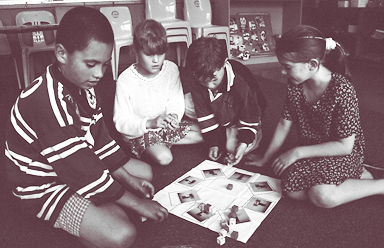The assessments
included nine tasks which investigated students' understandings, processes
and skills in the area of mathematics called geometry. Geometry is concerned
with geometrical relations in two and three dimensions, and their occurrence
in the environment. It also involves recognition of the geometrical properties
of everyday objects and the use of geometric models as aids to solving
problems.
Two tasks were
identical for both year 4 and year 8. Four tasks had overlapping versions
for year 4 and year 8 students, with some parts common to both levels.
Two tasks were attempted by year 8 students only, and one by year 4 only.
Three of the nine tasks have been selected as link tasks to be used again
in the year 2001, and therefore are not described in detail here. The
other tasks are released tasks for which full details are given.
The chapter presents
the assessment tasks in the following order:
 A high percentage
of year 8 students and a moderate percentage of year 4 students were
able to correctly identify and locate geometric positions in two dimensions,
but found the analysis of three dimensional attributes and relationships
more difficult. At year 4, less than half of the students were successful
in constructing a simple box (net) in accordance with the requirements
of the task. A quite high percentage of year 8 students could see relationships
between three dimensional objects and two dimensional aspects of those
same shapes when that relationship didn't require interpretation. When
interpretation was necessary, a high percentage of students struggled.
A moderate percentage of year 8 students and a low percentage of year
4 students succeeded in applying properties of symmetry to construct
geometric images. Both levels were more confident when drawing a line
of symmetry on a triangle. Generally high percentages of year 8 students,
and moderate to low percentages of year 4 students gave correct answers
to pencil and paper items which investigated a range of geometric knowledge.
Overall, results show progress between year 4 and year 8. On task components
common to both year levels, on average about 30 percent more year 8
students than year 4 students achieved success.
A high percentage
of year 8 students and a moderate percentage of year 4 students were
able to correctly identify and locate geometric positions in two dimensions,
but found the analysis of three dimensional attributes and relationships
more difficult. At year 4, less than half of the students were successful
in constructing a simple box (net) in accordance with the requirements
of the task. A quite high percentage of year 8 students could see relationships
between three dimensional objects and two dimensional aspects of those
same shapes when that relationship didn't require interpretation. When
interpretation was necessary, a high percentage of students struggled.
A moderate percentage of year 8 students and a low percentage of year
4 students succeeded in applying properties of symmetry to construct
geometric images. Both levels were more confident when drawing a line
of symmetry on a triangle. Generally high percentages of year 8 students,
and moderate to low percentages of year 4 students gave correct answers
to pencil and paper items which investigated a range of geometric knowledge.
Overall, results show progress between year 4 and year 8. On task components
common to both year levels, on average about 30 percent more year 8
students than year 4 students achieved success.